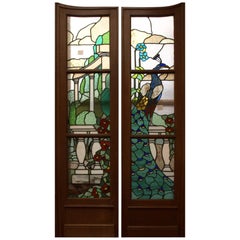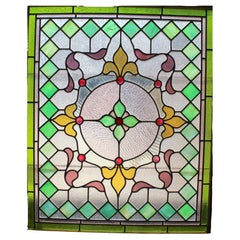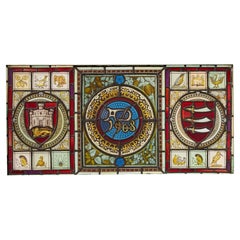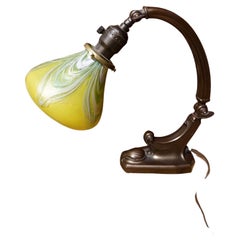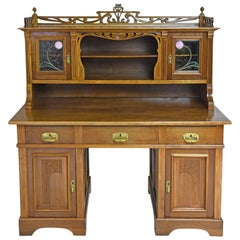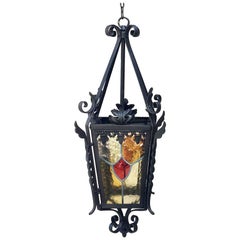Stained Glass Furniture
Early 20th Century European Aesthetic Movement Stained Glass Furniture
Stained Glass, Wood
Early 20th Century Stained Glass Furniture
Stained Glass
Early 20th Century English Arts and Crafts Stained Glass Furniture
Glass, Stained Glass, Wood, Pine
1910s German Art Nouveau Vintage Stained Glass Furniture
Brass
Early 1900s Belgian Art Nouveau Antique Stained Glass Furniture
Stained Glass, Walnut
1880s French Gothic Revival Antique Stained Glass Furniture
Iron
20th Century Italian Mid-Century Modern Stained Glass Furniture
Art Glass, Stained Glass, Opaline Glass, Murano Glass
20th Century English Medieval Stained Glass Furniture
Lead
21st Century and Contemporary Italian Mid-Century Modern Stained Glass Furniture
Brass
Early 19th Century North American Antique Stained Glass Furniture
Lead
2010s New Zealand Modern Stained Glass Furniture
Aluminum
Mid-19th Century English Medieval Antique Stained Glass Furniture
Lead
Mid-20th Century American Mid-Century Modern Stained Glass Furniture
Stained Glass, Oak
20th Century American Arts and Crafts Stained Glass Furniture
Stained Glass
Late 19th Century German Medieval Antique Stained Glass Furniture
Lead
Early 20th Century Stained Glass Furniture
Lead
Early 20th Century Stained Glass Furniture
Stained Glass
Early 20th Century Unknown Federal Stained Glass Furniture
Stained Glass, Mahogany
Early 20th Century Stained Glass Furniture
Stained Glass
1930s French Art Deco Vintage Stained Glass Furniture
Chrome
1950s French Mid-Century Modern Vintage Stained Glass Furniture
Cement, Iron
Late 19th Century English Victorian Antique Stained Glass Furniture
Glass, Stained Glass
Early 20th Century Unknown Stained Glass Furniture
Bronze
19th Century French Renaissance Antique Stained Glass Furniture
Wrought Iron
Late 20th Century English Mid-Century Modern Stained Glass Furniture
Lead
Early 20th Century Unknown Art Nouveau Stained Glass Furniture
Stained Glass, Wood
Early 20th Century Stained Glass Furniture
Stained Glass
2010s British Art Deco Stained Glass Furniture
Marble, Stone, Limestone, Carrara Marble, Slate, Metal, Brass, Bronze, C...
1910s English Arts and Crafts Vintage Stained Glass Furniture
Stained Glass
Early 20th Century American Stained Glass Furniture
Stained Glass
Early 20th Century Stained Glass Furniture
Lead
Mid-19th Century English Victorian Antique Stained Glass Furniture
Lead
1960s Unknown Vintage Stained Glass Furniture
Metal
Late 19th Century English Victorian Antique Stained Glass Furniture
Glass, Stained Glass, Wood, Pine
Mid-19th Century English Country Antique Stained Glass Furniture
Lead
21st Century and Contemporary Italian Modern Stained Glass Furniture
Brass
1960s Italian Mid-Century Modern Vintage Stained Glass Furniture
Stained Glass
20th Century Italian Mid-Century Modern Stained Glass Furniture
Brass
1950s Italian Mid-Century Modern Vintage Stained Glass Furniture
Stained Glass, Birch, Burl
Late 19th Century European Gothic Revival Antique Stained Glass Furniture
Lead
1960s Italian Mid-Century Modern Vintage Stained Glass Furniture
Brass
Early 20th Century American Art Nouveau Stained Glass Furniture
Stained Glass
Early 1900s French Art Deco Antique Stained Glass Furniture
Marble, Bronze
1970s German Mid-Century Modern Vintage Stained Glass Furniture
Stained Glass, Ash
Mid-20th Century Dutch Art Deco Stained Glass Furniture
Lead
20th Century Art Deco Stained Glass Furniture
Stained Glass
Late 19th Century English Art Nouveau Antique Stained Glass Furniture
Glass, Stained Glass, Wood, Mahogany
Late 19th Century Unknown Art Nouveau Antique Stained Glass Furniture
Stained Glass
Early 20th Century Chinese Stained Glass Furniture
Stained Glass, Wood
21st Century and Contemporary Italian Mid-Century Modern Stained Glass Furniture
Brass
20th Century British Stained Glass Furniture
Stained Glass
18th Century Italian Rustic Antique Stained Glass Furniture
Wrought Iron
1950s Italian Vintage Stained Glass Furniture
Brass
Late 19th Century Scottish Antique Stained Glass Furniture
Lead
Late 19th Century English Antique Stained Glass Furniture
Glass, Stained Glass, Wood, Pine
Early 20th Century Stained Glass Furniture
Stained Glass
Early 20th Century French Arts and Crafts Stained Glass Furniture
Wrought Iron
Early 20th Century British Arts and Crafts Stained Glass Furniture
Lead
Early 20th Century Stained Glass Furniture
Lead
21st Century and Contemporary Italian Mid-Century Modern Stained Glass Furniture
Brass
